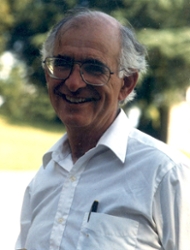

|

|
IN MEMORIAM
Seymour Chatman
Professor of Rhetoric and Film, Emeritus
UC Berkeley
1928 – 2015
Seymour Chatman died at his home in Berkeley November 4, 2015, at the age of 87. An internationally acclaimed literary critic and narratologist, he introduced and refined many of the basic terms used to describe narrative. In 2012, the International Society for the Study of Narrative conferred on Seymour Chatman a Lifetime Achievement Award for the “foundational contributions his work has made to the discipline of narrative theory,” citing particularly the “the brilliance and impact” of his 1978 book, Story and Discourse: Narrative Structure in Fiction and Film.
Born August 30, 1928, in Detroit, Michigan, Seymour received his B.A. (1948) and M.A. (1950) degrees in English from Wayne State University. At Cornell University in 1951-52, he worked as a Research Associate on a translation project sponsored by the State Department, then spent 1952-53 as a Fulbright Scholar at the University of Groningen, Holland. He received his Ph.D. in English language and literature from the University of Michigan, Ann Arbor, in 1956 and became an Assistant Professor of English at the University of Pennsylvania from 1956 until 1960 when he joined the faculty at Berkeley. After serving for a year as Lecturer in the English Department, Seymour moved to a ladder faculty position in the Department of Speech in 1961 and was a founding member in the 1960s of what became the Rhetoric Department in 1970.
The evolution of the Speech Department into the present-day Department of Rhetoric with its emphasis on discourse theory and practice in many ways paralleled the intellectual trajectory of Seymour’s scholarly career during the nineteen sixties and seventies. Although he was perhaps less involved in the administrative matters of creating a new department than in substantive intellectual ones, his role in creating vibrant, interdisciplinary fields cannot be underestimated. Seymour Chatman’s international standing as a leading literary theorist and narratologist drew graduate students interested in newly emerging continental structuralist approaches, as well as visiting critical theorists and filmmakers. His teaching and scholarly interests eventually led to a program in film and to the current Department of Film and Media, and certainly also contributed to the genesis of a program in Critical Theory. He pioneered the study of film at Berkeley with his successful course “Novel into Film” and served as faculty advisor to Berkeley’s first doctoral students in film, many of whom went on to establish influential film studies journals and programs at American and European universities.
Seymour was an inspiring teacher, a genial colleague and collaborator. In her commendation of him on behalf of the International Society for the Study of Narrative, Dorothy Hale points to Seymour’s “career-long habits of critical inquiry, theoretical creativity, and professional engagement that helped create a scholarly world” that mattered, that generated excitement and rigorous debate within a strong professional community. He was at the center of important symposia, bringing together thinkers whose debates, when edited and published, resulted in disciplinary transformation.
Seymour was the editor and translator of Literary Style: A Symposium––a controversial 1971 volume of essays from an international symposium that continued an intellectual exchange begun at the 1960 Indiana University conference on “Style in Language.” Seymour conceived of the meeting and organized the event that took place in 1969 in Bellagio, Italy, at the Rockefeller Foundation’s Villa Serbelloni. Among the linguists and literary critics he invited to participate in the conversation were Roman Jakobson, Josephine Miles, Pierre Guiraud, Rene Wellek, W.K. Wimsatt, Jean Starobinski, Steven Ullman, Tzvetan Todorov, Ivan Fonagy, Paul Zumthor, Ruqaiya Hasan, and Roland Barthes. Further breakthrough symposia followed, including Approaches to Poetics of the 1973 English Institute; the Proceedings of the First International Congress on Semiotics, edited with Umberto Eco; and in 1981, On Narrative, a special issue of Critical Inquiry.
Seymour’s international prominence brought him many honors and awards––including two Fulbrights, a Guggenheim Fellowship, five NEH Fellowships, a Rockefeller Grant, an IREX Travelling Fellowship to Poland and Russia, guest professorships at the University of Zurich and the University of Bologna where he was Plenary Lecturer at the Alma Mater Sudiorum Saecularia Nona in October 1988 for the 900th Anniversary, and the University of Melbourne 1991 where he was a Pacific Rim Exchange Professor.
Seymour enjoyed a long teaching career in the Department of Rhetoric and continued to teach as a Professor in the Graduate School for a decade after his retirement in 1993. Reading Narrative Fiction (Macmillan 1993) detailed his teaching methods and made the study of narrative accessible to a broader audience of teachers and readers. Pedagogic concerns were at the center of all his work. For Seymour, the end of all the high theory was the classroom where he taught students how to read, how to take pleasure in the discovery of story and narrative strategies through analysis of small-scale and large-scale effects of language and textual meaning.
A celebration of the life of Seymour Benjamin Chatman took place February 12, 2016 in the Morrison Library on the Berkeley campus. Speakers included his former students, friends, and colleagues: Emeritus Professor of Psychology and Linguistics; Dan Slobin; UC Santa Barbara Film and Media Studies Professor Constance Penley; Professor of English, Dorothy Hale; and, Rhetoric Lecturer, Marilyn Fabe.
Seymour Chatman is survived by his wife, Barbara Blomer, and his daughters: Emily Chatman Duffy, Jennifer A. Chatman, and Mariel Chatman Lasalle.
Bridget Connelly